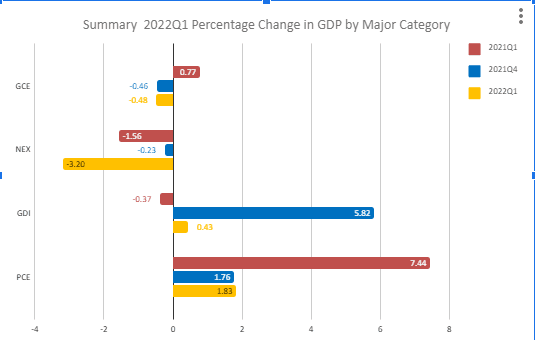- Topline GDP printed down 1.4 percent versus a consensus estimate of 1.1 percent up.
- Personal consumption expenditures (PCE) were sharply lower, year-on-year, as the economy normalizes
- The backlog of container ships that stood offshore at the end of last year has largely been cleared, and the U.S. has imported more oil and gas at higher prices, having a negative effect on the net exports (NEX) component of GDP and pushing the entire GDP print negative.
- Given that anomaly, the Federal Reserve is still likely to push rates higher when it meets May 4-6.
- Gross domestic investment (GDI) dropped as rates increased and concerns about business conditions increase.
DATA SUMMARY
This morning’s print of 2022 first quarter GDP (2022Q1) largely disappointed observers, including us, who had anticipated a higher print. (We had anticipated a print of 1 to 1.5 percent in our jobs report at the beginning of the month.)SOURCE: The Stuyvesant Square Consultancy © from Bureau of Economic Analysis Data
SOURCE: The Stuyvesant Square Consultancy © from Bureau of Economic Analysis Data
Other Economic Data
Economic optimism rose in early April, according to polling by IBD/TIPP. Data maintained by the Census Bureau is largely mixed, but with some troubling elements. Residential construction has slowed and inventories have increased. Personal consumption expenditures decreased in February in constant dollars. Margin debt has decreased as the market reduces risk in the face of virtually inevitable Federal Reserve rate hikes.Other Considerations
Geopolitics
Aside from Eastern Europe and the Ukraine war, there does not seem to be any looming “black swan” events. However, Ukraine’s status as the “breadbasket” of Eastern Europe and a large exporter of foodstuffs, and Russia’s status as the world’s largest fertilizer exporter, may exacerbate inflation and political instability as explained here.Russia’s Gazprom has closed off natural gas sales to Poland and Bulgaria after demanding payment in rubles to avoid Western sanctions on the Russian currency. The European Union (EU) gets about 30 percent of its oil and 40 percent of its natural gas from Russia (Poland gets 45 percent), so fuel prices and inflation in Europe are rising. The EU says it has prepared for the situation and is working to maintain the best possible situation, with other EU countries assisting Bulgaria and Poland with their supplies. Nevertheless, Eurozone inflation is almost certain to get worse.
As of April 25, the United States Navy has two carrier strike groups (CSG), led by the USS Abraham Lincoln and USS Ronald Reagan, along with an amphibious response group, deployed in the far Western Pacific, which will likely deter China from taking advantage of the focus in Ukraine. The USS Harry S. Truman CSG is in the Adriatic.
Currency Developments
The ruble has largely recovered from what is now the apparently failed U.S.-led effort to undermine the Bank of Russia, the Russian central bank. The USD:RUB pair, at 1:73 is roughly what it was in February, after soaring past 100 in February and March.The USD:JPY has moved past 1:130 for the first time in 30 years. The Bank of Japan has said that it will keep the yield at 0.25; meanwhile, in a seemingly contradictory move, the Ministry of Finance says it will defend the yen. Currency vigilantes are likely circling to take advantage.
The next meeting of the European Central Bank (ECB) monetary council is June 9. It’s unclear whether it will raise rates; we expect it will, by at least a quarter-point.
Opinion and Outlook
We are clearly in what I call “bear market stagflation“. The Dow Jones Industrial index has fallen 8.5 percent since the beginning of the year, which likely affected the drop in consumer spending in the first quarter.The first quarter’s negative print of NEX is likely an anomaly and the highest increase since 2020Q3, at the height of the pandemic. (In the four prior quarters, NEX averaged just -0.81 percent. Pre-pandemic, for 2019, quarterly NEX averaged just + 0.35 percent. ) NEX is also the element of GDP most prone to large revisions in later estimates.
Consequently, we think the Fed will boost rates by the half percentage point that most anticipate.
We think the second quarter GDP will print more positively, in the range of 0.5 percent to 1.5 percent. We'll be able to target that somewhat more precisely when we revise it after the April jobs report prints May 6, coterminous with the end of the Fed meeting.







